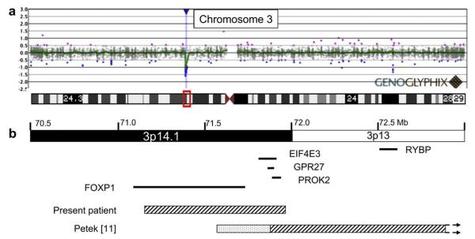What is Chromosome 3?
(from the Genetics Home Reference website Chromosome 3 page)
Humans normally have 46 chromosomes in each cell, divided into 23 pairs. Two copies of chromosome 3, one copy inherited from each parent, form one of the pairs. Chromosome 3 spans almost 200 million base pairs (the building blocks of DNA) and represents approximately 6.5 percent of the total DNA in cells.
Identifying genes on each chromosome is an active area of genetic research. Because researchers use different approaches to predict the number of genes on each chromosome, the estimated number of genes varies. Chromosome 3 likely contains between 1,100 and 1,500 genes. These genes perform a variety of different roles in the body.
Genes on chromosome 3are among the estimated 20,000 to 25,000 total genes in the human genome.
(from the Genetics Home Reference website Chromosome 3 page)
Humans normally have 46 chromosomes in each cell, divided into 23 pairs. Two copies of chromosome 3, one copy inherited from each parent, form one of the pairs. Chromosome 3 spans almost 200 million base pairs (the building blocks of DNA) and represents approximately 6.5 percent of the total DNA in cells.
Identifying genes on each chromosome is an active area of genetic research. Because researchers use different approaches to predict the number of genes on each chromosome, the estimated number of genes varies. Chromosome 3 likely contains between 1,100 and 1,500 genes. These genes perform a variety of different roles in the body.
Genes on chromosome 3are among the estimated 20,000 to 25,000 total genes in the human genome.
WYATT'S CHROMOSOME 3 DELETION - WHAT DOES IT LOOK LIKE?

I have a DELETION of part of Chromosome 3 between the section labeled 14.3 to 14.1, including the Fox P1 Gene. In my case, this was a de novo event, meaning, " An alteration in a gene that is present for the first time in one family member as a result of a mutation in a germ cell (egg or sperm) of one of the parents or in the fertilized egg itself." The picture shows exactly where on the little teeny, tiny strand there is a missing piece. The picture is from an article that I have on my Cool Sites page. The following information was found on the Lucile Packard Children's Hospital website:
"What are chromosomal abnormalities? Chromosomal abnormalities in the baby may be inherited from the parent or may occur with no family history. The following chromosomal problems are the most common:
- aneuploidy - more or fewer chromosomes than the normal number, including:
- Down syndrome (trisomy 21) - cells contain three #21 chromosomes)
- Turner syndrome (one of the two sex chromosomes is not transferred, leaving a single X chromosome, or 45 total).
- Down syndrome (trisomy 21) - cells contain three #21 chromosomes)
- deletion - part of a chromosome is missing, or part of the DNA code is missing.
- inversion - when a chromosome breaks and the piece of the chromosome turns upside down and reattaches itself. Inversions may or may not cause birth defects depending upon their exact structure.
- translocation - a rearrangement of a chromosome segment from one location to another, either within the same chromosome or to another.
- balanced translocation - the DNA is equally exchanged between chromosomes and none is lost or added. A parent with a balanced translocation is healthy, but he/she may be at risk for passing unbalanced chromosomes in a pregnancy.
- Robertsonian translocation - a balanced translocation in which one chromosome joins the end of another.
- balanced translocation - the DNA is equally exchanged between chromosomes and none is lost or added. A parent with a balanced translocation is healthy, but he/she may be at risk for passing unbalanced chromosomes in a pregnancy.
- mosaicism - the presence of two or more chromosome patterns in the cells of a person, resulting in two or more cell lines (i.e., some with 46 chromosomes, others with 47)."
